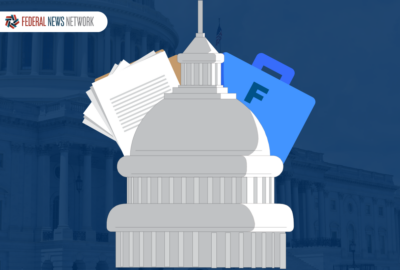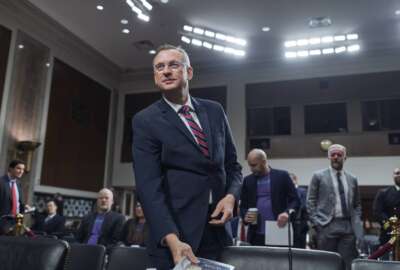Insight by Okta
Government CX means anticipating, not just reacting, to customer expectations
LaRel Rogers, senior product marketing manager for federal at Okta, says next-level CX improvements will require agencies to adopt predictive technology.
The federal government is holding agencies accountable to a higher standard for customer service.
High-Impact Service Providers (HISPs) across government are improving their customer experience through Voice of the Customer programs, in which agencies incorporate user feedback into improved processes and CX updates.
LaRel Rogers, senior product marketing manager for federal at Okta, says next-level CX improvements will require agencies to adopt predictive technology solutions that will allow them to anticipate their customers’ needs.
“What I’ve discovered across any of the High-Impact Service Providers, or any government customer experience initiatives, is that they’re actually focused on feedback. But the feedback tends to be really on post-transaction feedback or at the completion of their service journey,” Rogers said.
As agencies roll out more automation and artificial intelligence tools, Rogers said CX experts will have more data to make informed decisions about what their customers need and identify pain points.
“If you’re thinking of rolling out automated chat systems, when people are interacting with your agency benefit or service, there are things that you can predict that should happen as part of that interaction,” Rogers said.
Performance.gov outlines 11 common features of “what the American people should expect of their government” when it comes to service delivery. Among those features, agencies are expected to provide digital-first experiences through online forms, offer more self-service options, and enable secure identity verification.
‘Good enough for government’ is no longer good enough for customers
Rogers said it’s important for government to have “built-in requirements” for CX delivery.
“You shouldn’t have to go through a transaction or have a survey completed to know that you have to deliver on those service expectations,” she said.
Jason Miller, the Office of Management and Budget’s deputy director for management, looking back at the second anniversary of the Biden administration’s CX executive order, said in December 2023 that agencies should not be satisfied with the current delivery of government services and never again say, “It’s good enough for government work.”
“There’s so much happening around customer experience that you cannot deny the work that government is doing,” Rogers said. “The work doesn’t stop. And that’s why feedback is just one of many ways government is working to ensure they’re doing more than just good enough,” Rogers said.
Customers expect a personalized customer experience, and are often frustrated submitting the same information on multiple forms. By connecting backend systems, Rogers said agencies will have a 360-degree view of a customer’s journey and can reduce duplicative processes.
“You might connect the automated chat system with your ticketing system. And now the ticketing system has the appropriate information and can respond based on those attributes. So based on where this person lives and what they’re requesting, they can get an automatic notification sent to their phone.”
Agencies must also provide public-facing services that are secure by default and set clear boundaries on acceptable uses of Personally Identifiable Information (PII).
“Handing over my personal information to get an agreed-upon benefit or service is the end goal. But I shouldn’t have my data compromised in any way by doing that. That’s where access management comes into play,” Rogers said.
Making your CX toolkit ‘work for you’
Agencies have more options than ever regarding CX tools, services, and solutions. Rogers, however, said effective CX delivery means “spreading your CX toolkit thin, but not spreading your employees thin.”
Rogers cautioned agencies against “rolling out things for the sake of keeping up with the latest trends like AI” but taking a more intentional approach “that has a connection point between what the customer is giving you and the tools that you have available in your toolkit.”
“[It’s] spreading your toolkit in a manner that you might not have the budget to buy all of these different things, but you’re making it work for you,” she said.
Investing in the right CX tools will also empower frontline employees and their teams to provide customers with the service they expect.
“Obviously, there’s still work to be done to build out customer experience strategist officers or officers within different agencies, and that continues to be a priority. [But] it’s not like they’re getting tons of people coming in. It might be just one or two if they’re lucky. So, you want to be mindful of the resources that you have … making sure that they have actionable research that they’re able to put in place, making sure the technology put in place is utilized beyond what you would think.”
CX experts in government serve multiple roles in their agencies — technology, project management, and design experts. But Rogers said meaningful CX delivery requires a team approach.
“To empower this workforce to create change, you can’t have them bogged down with things that are outside their expertise. Naturally, human-centered design is a big area of focus for CX specialists. But having them become a human-centered design specialist and a change management agent, at the same time that they’re becoming a security specialist probably doesn’t benefit them or the strategy that they’re trying to put in place. So, identifying the service requirements they can put in place helps with that, and helps them weed through all of the available CX toolkit technologies available to empower them and sustain focus on reducing a burden for their customers.”
Discover more about how to elevate your customer experience in the “Excellent, equitable and secure customer experience: A closer look at high-impact service providers” series.
Copyright © 2025 Federal News Network. All rights reserved. This website is not intended for users located within the European Economic Area.
Jory Heckman is a reporter at Federal News Network covering U.S. Postal Service, IRS, big data and technology issues.
Follow @jheckmanWFED






